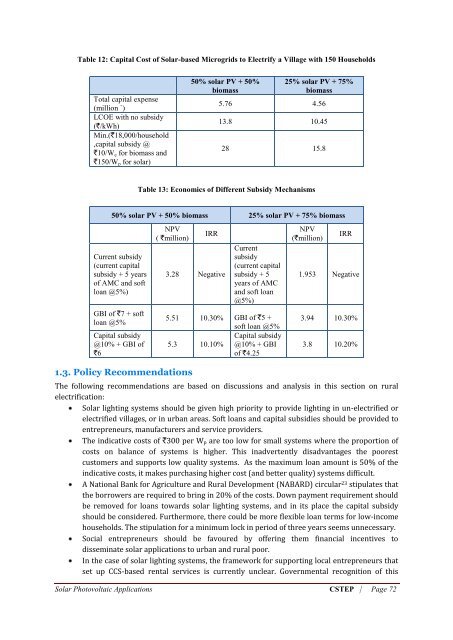Harnessing Solar energy, Options for India
A study on harnessing solar energy options for India was conducted recently by Shakti Sustainable Energy Foundation, Climate works Foundation and SSN foundation. Supporting this study it has been concluded that solar energy can play a big role in providing electricity to rural areas and thus has been included in India’s rural electrification policy. See more at: http://shaktifoundation.in/report/harnessing-solar-energy-options-for-india/
A study on harnessing solar energy options for India was conducted recently by Shakti Sustainable Energy Foundation, Climate works Foundation and SSN foundation. Supporting this study it has been concluded that solar energy can play a big role in providing electricity to rural areas and thus has been included in India’s rural electrification policy. See more at: http://shaktifoundation.in/report/harnessing-solar-energy-options-for-india/
Create successful ePaper yourself
Turn your PDF publications into a flip-book with our unique Google optimized e-Paper software.
Table 12: Capital Cost of <strong>Solar</strong>-based Microgrids to Electrify a Village with 150 Households<br />
Total capital expense<br />
(million `)<br />
LCOE with no subsidy<br />
(`/kWh)<br />
Min.(`18,000/household<br />
,capital subsidy @<br />
`10/W e <strong>for</strong> biomass and<br />
`150/W p <strong>for</strong> solar)<br />
50% solar PV + 50%<br />
biomass<br />
25% solar PV + 75%<br />
biomass<br />
5.76 4.56<br />
13.8 10.45<br />
28 15.8<br />
Table 13: Economics of Different Subsidy Mechanisms<br />
50% solar PV + 50% biomass 25% solar PV + 75% biomass<br />
Current subsidy<br />
(current capital<br />
subsidy + 5 years<br />
of AMC and soft<br />
loan @5%)<br />
GBI of `7 + soft<br />
loan @5%<br />
Capital subsidy<br />
@10% + GBI of<br />
`6<br />
NPV<br />
( `million)<br />
1.3. Policy Recommendations<br />
IRR<br />
3.28 Negative<br />
Current<br />
subsidy<br />
(current capital<br />
subsidy + 5<br />
years of AMC<br />
and soft loan<br />
@5%)<br />
5.51 10.30% GBI of `5 +<br />
soft loan @5%<br />
Capital subsidy<br />
5.3 10.10% @10% + GBI<br />
of `4.25<br />
NPV<br />
(`million)<br />
<strong>Solar</strong> Photovoltaic Applications CSTEP | Page 72<br />
IRR<br />
1.953 Negative<br />
3.94 10.30%<br />
3.8 10.20%<br />
The following recommendations are based on discussions and analysis in this section on rural<br />
electrification:<br />
<strong>Solar</strong> lighting systems should be given high priority to provide lighting in un-electrified or<br />
electrified villages, or in urban areas. Soft loans and capital subsidies should be provided to<br />
entrepreneurs, manufacturers and service providers.<br />
The indicative costs of `300 per W p are too low <strong>for</strong> small systems where the proportion of<br />
costs on balance of systems is higher. This inadvertently disadvantages the poorest<br />
customers and supports low quality systems. As the maximum loan amount is 50% of the<br />
indicative costs, it makes purchasing higher cost (and better quality) systems difficult.<br />
A National Bank <strong>for</strong> Agriculture and Rural Development (NABARD) circular 23 stipulates that<br />
the borrowers are required to bring in 20% of the costs. Down payment requirement should<br />
be removed <strong>for</strong> loans towards solar lighting systems, and in its place the capital subsidy<br />
should be considered. Furthermore, there could be more flexible loan terms <strong>for</strong> low-income<br />
households. The stipulation <strong>for</strong> a minimum lock in period of three years seems unnecessary.<br />
Social entrepreneurs should be favoured by offering them financial incentives to<br />
disseminate solar applications to urban and rural poor.<br />
In the case of solar lighting systems, the framework <strong>for</strong> supporting local entrepreneurs that<br />
set up CCS-based rental services is currently unclear. Governmental recognition of this

















